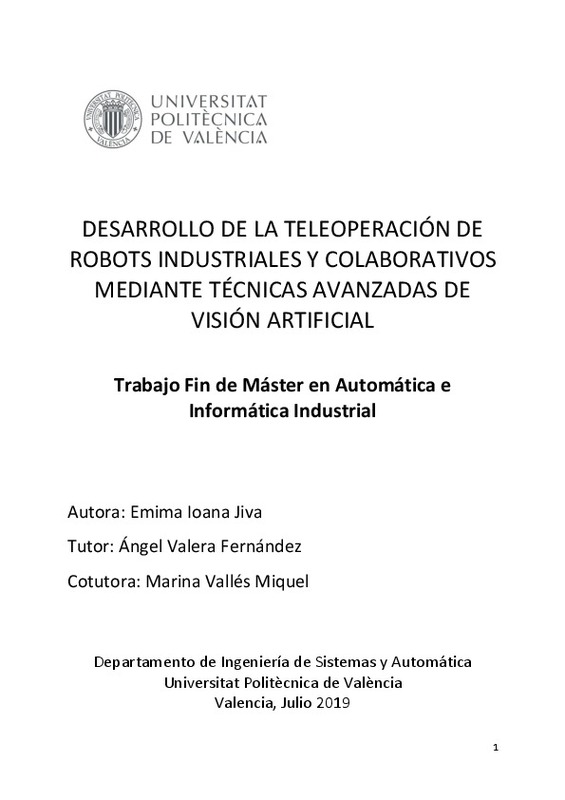|
Resumen:
|
[ES] Actualmente la robótica está teniendo un crecimiento muy grande, siendo la piedra angular de lo que se conoce como la Industria 4.0. Para facilitar la implantación de los sistemas robotizados en la industria general, ...[+]
[ES] Actualmente la robótica está teniendo un crecimiento muy grande, siendo la piedra angular de lo que se conoce como la Industria 4.0. Para facilitar la implantación de los sistemas robotizados en la industria general, y la pequeña y mediana empresa en particular, los robots deben tener una serie de características: deben ser económicos, fáciles de utilizar, versátiles, etc.
En este Trabajo Fin de Máster (TFM) se propone desarrollar una aplicación para que pueda teleoperar sistemas robotizados. Para que sea lo más eficiente posible, se debe permitir que la interacción entre el operario y el robot sea lo más directo y natural posible. Además, debería permitir la teleoperación de diferentes sistemas robotizados.
Para permitir una interacción natural, en este TFM se propone utilizar técnicas avanzadas de visión artificial. Gracias a estas técnicas, la cámara de visión detectará la posición y los movimientos del brazo del operario, de forma que se mandará dicha información a la unidad de control del robot para generar las referencias de movimiento de los robots.
Los robots a utilizar en este TFM son los robots disponibles en el Dpto. de Ingeniería de Sistemas y Automática y el Instituto U. de Automática e Informática Industrial. En concreto se trabajará con del robot IRB140, un robot industrial compacto de 6 grados de libertad. Además, se deberá programas y controlar también el robot YUMI, un robot colaborativo de última generación compuesto por 2 brazos y un total de 14 grados de libertad.
[-]
[CA] Actualment la robòtica està tenint un creixement molt gran, sent la pedra angular del que es coneix
com la Indústria 4.0. Per a facilitar la implantació dels sistemes robotitzats en la indústria general, i la
xicoteta ...[+]
[CA] Actualment la robòtica està tenint un creixement molt gran, sent la pedra angular del que es coneix
com la Indústria 4.0. Per a facilitar la implantació dels sistemes robotitzats en la indústria general, i la
xicoteta i mitjana empresa en particular, els robots han de tindre una sèrie de característiques: han de
ser econòmics, fàcils d'utilitzar, versàtils, etc.
En aquest Treball Fi de Màster (TFM) es proposa fer una aplicació perquè puga teleoperar sistemes
robotitzats. Perquè siga el més eficient possible, s'ha de permetre que la interacció entre l'operari i el
robot siga el més directe i natural possible. A més, hauria de permetre la teleoperació de diferents
sistemes robotitzats.
Per a permetre una interacció natural, en aquest TFM es proposa utilitzar tècniques avançades de visió
artificial. Gràcies a aquestes tècniques, la càmara de visió detectarà la posició i els moviments del braç
de l'operari, de manera que es manarà la dita informació a la unitat de control del robot per a generar
les referències de moviment dels robots.
Els robots a utilitzar en aquest TFM són els robots disponibles en el Dpto. d'Enginyeria de Sistemes i
Automàtica i l'Institut U. d'Automàtica i Informàtica Industrial. En concret es treballarà amb del robot
IRB140, un robot industrial compacte de 6 graus de llibertat. A més, s'haurà de programar i controlar
també el robot YUMI, un robot col·laboratiu d'última generació format per 2 braços i un total de 14
graus de llibertat.
[-]
[EN] Currently, robotics are having a very large growth, being the cornerstone of what is known as Industry
4.0. To facilitate the implementation of robotic systems in general industry, and small and medium
enterprises ...[+]
[EN] Currently, robotics are having a very large growth, being the cornerstone of what is known as Industry
4.0. To facilitate the implementation of robotic systems in general industry, and small and medium
enterprises in particular, robots must have a number of characteristics: they must be economical, easy
to use, versatile, etc.
In this Final Master's Project (TFM) it is proposed to develop an application so that it can teleoperate
robotic systems. To be as efficient as possible, the interaction between the operator and the robot
must be allowed to be as direct and natural as possible. In addition, it should allow teleoperation of
different robotic systems.
To allow a natural interaction, in this TFM it is proposed to use advanced artificial vision techniques.
Thanks to these techniques, the vision camera will detect the position and movements of the
operator's arm, so that this information will be sent to the robot control unit to generate the
movement references of the robots.
The robots to be used in this TFM are the robots available in the Dept. of Systems Engineering and
Automation and the U. Institute of Automation and Industrial Computing. In particular we will work
with the IRB140 robot, a compact industrial robot with 6 degrees of freedom. In addition, the YUMI
robot, a last-generation collaborative robot composed of 2 arms and a total of 14 degrees of freedom,
must also be programmed and controlled.
[-]
|







